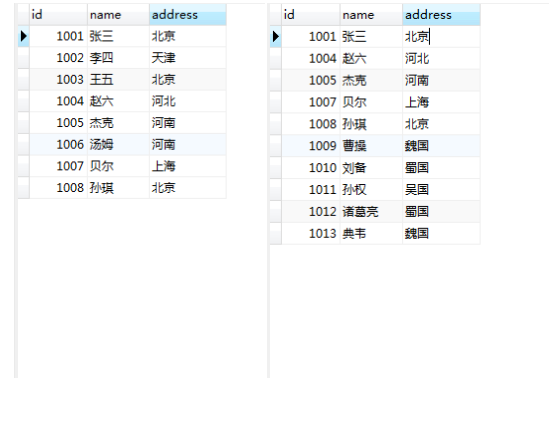不要再問我 In,Exists 走不走索引了...
前言
最近,有一個業(yè)務(wù)需求,給我一份數(shù)據(jù) A ,把它在數(shù)據(jù)庫 B 中存在,而又比 A 多出的部分算出來。由于數(shù)據(jù)比較雜亂,我這里簡化模型。
然后就會發(fā)現(xiàn),我去,這不就是 not in ,not exists 嘛。
那么問題來了,in, not in , exists , not exists 它們有什么區(qū)別,效率如何?
曾經(jīng)從網(wǎng)上聽說,in 和 exists 不會走索引,那么事實真的是這樣嗎?
帶著疑問,我們研究下去。
注意: 在說這個問題時,不說明 MySQL 版本的都是耍流氓,我這里用的是 5.7.18 。
用法講解
為了方便,我們創(chuàng)建兩張表 t1 和 t2 。并分別加入一些數(shù)據(jù)。(id為主鍵,name為普通索引)
- -- t1
- DROP TABLE IF EXISTS `t1`;
- CREATE TABLE `t1` (
- `id` int(11) NOT NULL AUTO_INCREMENT,
- `name` varchar(255) DEFAULT NULL,
- `address` varchar(255) DEFAULT NULL,
- PRIMARY KEY (`id`),
- KEY `idx_t1_name` (`name`(191)) USING BTREE
- ) ENGINE=InnoDB AUTO_INCREMENT=1009 DEFAULT CHARSET=utf8mb4;
- INSERT INTO `t1` VALUES ('1001', '張三', '北京'), ('1002', '李四', '天津'), ('1003', '王五', '北京'), ('1004', '趙六', '河北'), ('1005', '杰克', '河南'), ('1006', '湯姆', '河南'), ('1007', '貝爾', '上海'), ('1008', '孫琪', '北京');
- -- t2
- DROP TABLE IF EXISTS `t2`;
- CREATE TABLE `t2` (
- `id` int(11) NOT NULL AUTO_INCREMENT,
- `name` varchar(255) CHARACTER SET utf8mb4 COLLATE utf8mb4_general_ci NULL DEFAULT NULL,
- `address` varchar(255) CHARACTER SET utf8mb4 COLLATE utf8mb4_general_ci NULL DEFAULT NULL,
- PRIMARY KEY (`id`) USING BTREE,
- INDEX `idx_t2_name`(`name`(191)) USING BTREE
- ) ENGINE = InnoDB AUTO_INCREMENT = 1014 CHARACTER SET = utf8mb4 COLLATE = utf8mb4_general_ci ROW_FORMAT = Dynamic;
- INSERT INTO `t2` VALUES (1001, '張三', '北京');
- INSERT INTO `t2` VALUES (1004, '趙六', '河北');
- INSERT INTO `t2` VALUES (1005, '杰克', '河南');
- INSERT INTO `t2` VALUES (1007, '貝爾', '上海');
- INSERT INTO `t2` VALUES (1008, '孫琪', '北京');
- INSERT INTO `t2` VALUES (1009, '曹操', '魏國');
- INSERT INTO `t2` VALUES (1010, '劉備', '蜀國');
- INSERT INTO `t2` VALUES (1011, '孫權(quán)', '吳國');
- INSERT INTO `t2` VALUES (1012, '諸葛亮', '蜀國');
- INSERT INTO `t2` VALUES (1013, '典韋', '魏國');
那么,對于當(dāng)前的問題,就很簡單了,用 not in 或者 not exists 都可以把 t1 表中比 t2 表多出的那部分?jǐn)?shù)據(jù)給挑出來。(當(dāng)然,t2 比 t1 多出來的那部分不算)
這里假設(shè)用 name 來匹配數(shù)據(jù)。
- select * from t1 where name not in (select name from t2);
- 或者用
- select * from t1 where not exists (select name from t2 where t1.name=t2.name);
得到的結(jié)果都是一樣的。
但是,需要注意的是,not in 和 not exists 還是有不同點的。
在使用 not in 的時候,需要保證子查詢的匹配字段是非空的。如,此表 t2 中的 name 需要有非空限制。如若不然,就會導(dǎo)致 not in 返回的整個結(jié)果集為空。
例如,我在 t2 表中加入一條 name 為空的數(shù)據(jù)。
- INSERT INTO `t2` VALUES (1014, NULL, '魏國');
則此時,not in 結(jié)果就會返回空。
另外需要明白的是, exists 返回的結(jié)果是一個 boolean 值 true 或者 false ,而不是某個結(jié)果集。因為它不關(guān)心返回的具體數(shù)據(jù)是什么,只是外層查詢需要拿這個布爾值做判斷。
區(qū)別是,用 exists 時,若子查詢查到了數(shù)據(jù),則返回真。用 not exists 時,若子查詢沒有查到數(shù)據(jù),則返回真。
由于 exists 子查詢不關(guān)心具體返回的數(shù)據(jù)是什么。因此,以上的語句完全可以修改為如下,
- -- 子查詢中 name 可以修改為其他任意的字段,如此處改為 1 。
- select * from t1 where not exists (select 1 from t2 where t1.name=t2.name);
從執(zhí)行效率來說,1 > column > * 。因此推薦用 select 1。(準(zhǔn)確的說應(yīng)該是常量值)
in, exists 執(zhí)行流程
1、 對于 in 查詢來說,會先執(zhí)行子查詢,如上邊的 t2 表,然后把查詢得到的結(jié)果和外表 t1 做笛卡爾積,再通過條件進行篩選(這里的條件就是指 name 是否相等),把每個符合條件的數(shù)據(jù)都加入到結(jié)果集中。
sql 如下,
- select * from t1 where name in (select name from t2);
偽代碼如下:
- for(x in A){
- for(y in B){
- if(condition is true) {result.add();}
- }
- }
這里的 condition 其實就是對比兩張表中的 name 是否相同。
2、對于 exists 來說,是先查詢遍歷外表 t1 ,然后每次遍歷時,再檢查在內(nèi)表是否符合匹配條件,即檢查是否存在 name 相等的數(shù)據(jù)。
sql 如下,
- select * from t1 where name exists (select 1 from t2);
偽代碼如下:
- for(x in A){
- if(exists condition is true){result.add();}
- }
對應(yīng)于此例,就是從 id 為 1001 開始遍歷 t1 表 ,然后遍歷時檢查 t2 中是否有相等的 name 。
如 id=1001時,張三存在于 t2 表中,則返回 true,把 t1 中張三的這條記錄加入到結(jié)果集,繼續(xù)下次循環(huán)。id=1002 時,李四不在 t2 表中,則返回 false,不做任何操作,繼續(xù)下次循環(huán)。直到遍歷完整個 t1 表。
是否走索引?
針對網(wǎng)上說的 in 和 exists 不走索引,那么究竟是否如此呢?
我們在 MySQL 5.7.18 中驗證一下。(注意版本號哦)
單表查詢
首先,驗證單表的最簡單的情況。我們就以 t1 表為例,id為主鍵, name 為普通索引。
分別執(zhí)行以下語句,
- explain select * from t1 where id in (1001,1002,1003,1004);
- explain select * from t1 where id in (1001,1002,1003,1004,1005);
- explain select * from t1 where name in ('張三','李四');
- explain select * from t1 where name in ('張三','李四','王五');
為什么我要分別查不同的 id 個數(shù)呢?看截圖,
會驚奇的發(fā)現(xiàn),當(dāng) id 是四個值時,還走主鍵索引。而當(dāng) id 是五個值時,就不走索引了。這就很耐人尋味了。
再看 name 的情況,
同樣的當(dāng)值多了之后,就不走索引了。
所以,我猜測這個跟匹配字段的長度有關(guān)。按照漢字是三個字節(jié)來計算,且程序設(shè)計中喜歡用2的n次冪的尿性,這里大概就是以 16 個字節(jié)為分界點。
然而,我又以同樣的數(shù)據(jù),去我的服務(wù)器上查詢(版本號 5.7.22),發(fā)現(xiàn)四個id值時,就不走索引了。因此,估算這里的臨界值為 12 個字節(jié)。
不管怎樣,這說明了,在 MySQL 中應(yīng)該對 in 查詢的字節(jié)長度是有限制的。(沒有官方確切說法,所以,僅供參考)
多表涉及子查詢
我們主要是去看當(dāng)前的這個例子中的兩表查詢時, in 和 exists 是否走索引。
一、分別執(zhí)行以下語句,主鍵索引(id)和普通索引(name),在 in , not in 下是否走索引。
- explain select * from t1 where id in (select id from t2); --1
- explain select * from t1 where name in (select name from t2); --2
- explain select * from t1 where id not in (select id from t2); --3
- explain select * from t1 where name not in (select name from t2); --4
結(jié)果截圖如下,
1、t1 走索引,t2 走索引。
1
2、t1 不走索引,t2不走索引。(此種情況,實測若把name改為唯一索引,則t1也會走索引)
2
3、t1 不走索引,t2走索引。
3
4、t1不走索引,t2不走索引。
4
我滴天,這結(jié)果看起來亂七八糟的,好像走不走索引,完全看心情。
但是,我們發(fā)現(xiàn)只有第一種情況,即用主鍵索引字段匹配,且用 in 的情況下,兩張表才都走索引。
這個到底是不是規(guī)律呢?有待考察,且往下看。
二、接下來測試,主鍵索引和普通索引在 exists 和 not exists 下的情況。sql如下,
- explain select * from t1 where exists (select 1 from t2 where t1.id=t2.id);
- explain select * from t1 where exists (select 1 from t2 where t1.name=t2.name);
- explain select * from t1 where not exists (select 1 from t2 where t1.id=t2.id);
- explain select * from t1 where not exists (select 1 from t2 where t1.name=t2.name);
這個結(jié)果就非常有規(guī)律了,且看,
有沒有發(fā)現(xiàn), t1 表哪種情況都不會走索引,而 t2 表是有索引的情況下就會走索引。為什么會出現(xiàn)這種情況?
其實,上一小節(jié)說到了 exists 的執(zhí)行流程,就已經(jīng)說明問題了。
它是以外層表為驅(qū)動表,無論如何都會循環(huán)遍歷的,所以會全表掃描。而內(nèi)層表通過走索引,可以快速判斷當(dāng)前記錄是否匹配。
效率如何?
針對網(wǎng)上說的 exists 一定比 in 的執(zhí)行效率高,我們做一個測試。
分別在 t1,t2 中插入 100W,200W 條數(shù)據(jù)。
我這里,用的是自定義函數(shù)來循環(huán)插入,語句參考如下,(沒有把表名抽離成變量,因為我沒有找到方法,尷尬)
- -- 傳入需要插入數(shù)據(jù)的id開始值和數(shù)據(jù)量大小,函數(shù)返回結(jié)果為最終插入的條數(shù),此值正常應(yīng)該等于數(shù)據(jù)量大小。
- -- id自增,循環(huán)往 t1 表添加數(shù)據(jù)。這里為了方便,id、name取同一個變量,address就為北京。
- delimiter //
- drop function if exists insert_datas1//
- create function insert_datas1(in_start int(11),in_len int(11)) returns int(11)
- begin
- declare cur_len int(11) default 0;
- declare cur_id int(11);
- set cur_id = in_start;
- while cur_len < in_len do
- insert into t1 values(cur_id,cur_id,'北京');
- set cur_len = cur_len + 1;
- set cur_id = cur_id + 1;
- end while;
- return cur_len;
- end
- //
- delimiter ;
- -- 同樣的,往 t2 表插入數(shù)據(jù)
- delimiter //
- drop function if exists insert_datas2//
- create function insert_datas2(in_start int(11),in_len int(11)) returns int(11)
- begin
- declare cur_len int(11) default 0;
- declare cur_id int(11);
- set cur_id = in_start;
- while cur_len < in_len do
- insert into t2 values(cur_id,cur_id,'北京');
- set cur_len = cur_len + 1;
- set cur_id = cur_id + 1;
- end while;
- return cur_len;
- end
- //
- delimiter ;
在此之前,先清空表里的數(shù)據(jù),然后執(zhí)行函數(shù),
- select insert_datas1(1,1000000);
對 t2 做同樣的處理,不過為了兩張表數(shù)據(jù)有交叉,就從 70W 開始,然后插入 200W 數(shù)據(jù)。
- select insert_datas2(700000,2000000);
在家里的電腦,實際執(zhí)行時間,分別為 36s 和 74s。
不知為何,家里的電腦還沒有在 Docker 虛擬機中跑的腳本快。。害,就這樣湊合著用吧。
等我有了新歡錢,就把它換掉,哼哼。
同樣的,把上邊的執(zhí)行計劃都執(zhí)行一遍,進行對比。我這里就不貼圖了。
in 和 exists 孰快孰慢
為了方便,主要拿以下這兩個 sql 來對比分析。
- select * from t1 where id in (select id from t2);
- select * from t1 where exists (select 1 from t2 where t1.id=t2.id);
執(zhí)行結(jié)果顯示,兩個 sql 分別執(zhí)行 1.3s 和 3.4s 。
注意此時,t1 表數(shù)據(jù)量為 100W, t2 表數(shù)據(jù)量為 200W 。
按照網(wǎng)上對 in 和 exists 區(qū)別的通俗說法,
如果查詢的兩個表大小相當(dāng),那么用in和exists差別不大;如果兩個表中一個較小一個較大,則子查詢表大的用exists,子查詢表小的用in;
對應(yīng)于此處就是:
- 當(dāng) t1 為小表, t2 為大表時,應(yīng)該用 exists ,這樣效率高。
- 當(dāng) t1 為大表,t2 為小表時,應(yīng)該用 in,這樣效率較高。
而我用實際數(shù)據(jù)測試,就把第一種說法給推翻了。因為很明顯,t1 是小表,但是 in 比 exists 的執(zhí)行速度還快。
為了繼續(xù)測驗它這個觀點,我把兩個表的內(nèi)表外表關(guān)系調(diào)換一下,讓 t2 大表作為外表,來對比查詢,
- select * from t2 where id in (select id from t1);
- select * from t2 where exists (select 1 from t1 where t1.id=t2.id);
執(zhí)行結(jié)果顯示,兩個 sql 分別執(zhí)行 1.8s 和 10.0s 。
是不是很有意思。可以發(fā)現(xiàn),
- 對于 in 來說,大表小表調(diào)換了內(nèi)外層關(guān)系,執(zhí)行時間并無太大區(qū)別。一個是 1.3s,一個是 1.8s。
- 對于 exists 來說,大小表調(diào)換了內(nèi)外層關(guān)系,執(zhí)行時間天壤之別,一個是 3.4s ,一個是 10.0s,足足慢了兩倍。
一、以查詢優(yōu)化器維度對比。
為了探究這個結(jié)果的原因。我去查看它們分別在查詢優(yōu)化器中優(yōu)化后的 sql 。
- -- 此為 5.7 寫法,如果是 5.6版本,需要用 explain extended ...
- explain select * from t1 where id in (select id from t2);
- -- 本意為顯示警告信息。但是和 explain 一塊兒使用,就會顯示出優(yōu)化后的sql。需要注意使用順序。
- show warnings;
-- 此為 5.7 寫法,如果是 5.6版本,需要用 explain extended ...explain select * from t1 where id in (select id from t2);-- 本意為顯示警告信息。但是和 explain 一塊兒使用,就會顯示出優(yōu)化后的sql。需要注意使用順序。show warnings;
在結(jié)果 Message 里邊就會顯示我們要的語句。
- -- message 優(yōu)化后的sql
- select `test`.`t1`.`id` AS `id`,`test`.`t1`.`name` AS `name`,`test`.`t1`.`address` AS `address` from `test`.`t2` join `test`.`t1` where (`test`.`t2`.`id` = `test`.`t1`.`id`)
可以發(fā)現(xiàn),這里它把 in 轉(zhuǎn)換為了 join 來執(zhí)行。
這里沒有用 on,而用了 where,是因為當(dāng)只有 join 時,后邊的 on 可以用 where 來代替。即 join on 等價于 join where 。
PS: 這里我們也可以發(fā)現(xiàn),select * 最終會被轉(zhuǎn)化為具體的字段,知道為什么我們不建議用 select * 了吧。
同樣的,以 t2 大表為外表的查詢情況,也查看優(yōu)化后的語句。
- explain select * from t2 where id in (select id from t1);
- show warnings;
我們會發(fā)現(xiàn),它也會轉(zhuǎn)化為 join 的。
- select `test`.`t2`.`id` AS `id`,`test`.`t2`.`name` AS `name`,`test`.`t2`.`address` AS `address` from `test`.`t1` join `test`.`t2` where (`test`.`t2`.`id` = `test`.`t1`.`id`)
這里不再貼 exists 的轉(zhuǎn)化 sql ,其實它沒有什么大的變化。
二、以執(zhí)行計劃維度對比。
我們再以執(zhí)行計劃維度來對比他們的區(qū)別。
- explain select * from t1 where id in (select id from t2);
- explain select * from t2 where id in (select id from t1);
- explain select * from t1 where exists (select 1 from t2 where t1.id=t2.id);
- explain select * from t2 where exists (select 1 from t1 where t1.id=t2.id);
執(zhí)行結(jié)果分別為,
1

2
3
4
可以發(fā)現(xiàn),對于 in 來說,大表 t2 做外表還是內(nèi)表,都會走索引的,小表 t1 做內(nèi)表時也會走索引。看它們的 rows 一列也可以看出來,前兩張圖結(jié)果一樣。
對于 exists 來說,當(dāng)小表 t1 做外表時,t1 全表掃描,rows 近 100W;當(dāng) 大表 t2 做外表時, t2 全表掃描,rows 近 200W 。這也是為什么 t2 做外表時,執(zhí)行效率非常低的原因。
因為對于 exists 來說,外表總會執(zhí)行全表掃描的,當(dāng)然表數(shù)據(jù)越少越好了。
最終結(jié)論: 外層大表內(nèi)層小表,用in。外層小表內(nèi)層大表,in和exists效率差不多(甚至 in 比 exists 還快,而并不是網(wǎng)上說的 exists 比 in 效率高)。
not in 和 not exists 孰快孰慢
此外,實測對比 not in 和 not exists 。
- explain select * from t1 where id not in (select id from t2);
- explain select * from t1 where not exists (select 1 from t2 where t1.id=t2.id);
- explain select * from t1 where name not in (select name from t2);
- explain select * from t1 where not exists (select 1 from t2 where t1.name=t2.name);
- explain select * from t2 where id not in (select id from t1);
- explain select * from t2 where not exists (select 1 from t1 where t1.id=t2.id);
- explain select * from t2 where name not in (select name from t1);
- explain select * from t2 where not exists (select 1 from t1 where t1.name=t2.name);
小表做外表的情況下。對于主鍵來說, not exists 比 not in 快。對于普通索引來說, not in 和 not exists 差不了多少,甚至 not in 會稍快。
大表做外表的情況下,對于主鍵來說, not in 比 not exists 快。對于普通索引來說, not in 和 not exists 差不了多少,甚至 not in 會稍快。
感興趣的同學(xué),可自行嘗試。以上邊的兩個維度(查詢優(yōu)化器和執(zhí)行計劃)分別來對比一下。
join 的嵌套循環(huán) (Nested-Loop Join)
為了理解為什么這里的 in 會轉(zhuǎn)換為 join ,我感覺有必要了解一下 join 的三種嵌套循環(huán)連接。
1、簡單嵌套循環(huán)連接,Simple Nested-Loop Join ,簡稱 SNLJ
join 即是 inner join ,內(nèi)連接,它是一個笛卡爾積,即利用雙層循環(huán)遍歷兩張表。
我們知道,一般在 sql 中都會以小表作為驅(qū)動表。所以,對于 A,B 兩張表,若A的結(jié)果集較少,則把它放在外層循環(huán),作為驅(qū)動表。自然,B 就在內(nèi)層循環(huán),作為被驅(qū)動表。
簡單嵌套循環(huán),就是最簡單的一種情況,沒有做任何優(yōu)化。
因此,復(fù)雜度也是最高的,O(mn)。偽代碼如下,
- for(id1 in A){
- for(id2 in B){
- if(id1==id2){
- result.add();
- }
- }
- }
2、索引嵌套循環(huán)連接,Index Nested-Loop Join ,簡稱 INLJ
看名字也能看出來了,這是通過索引進行匹配的。外層表直接和內(nèi)層表的索引進行匹配,這樣就不需要遍歷整個內(nèi)層表了。利用索引,減少了外層表和內(nèi)層表的匹配次數(shù)。
所以,此種情況要求內(nèi)層表的列要有索引。
偽代碼如下,
- for(id1 in A){
- if(id1 matched B.id){
- result.add();
- }
- }
3、塊索引嵌套連接,Block Nested-Loop Join ,簡稱 BNLJ
塊索引嵌套連接,是通過緩存外層表的數(shù)據(jù)到 join buffer 中,然后 buffer 中的數(shù)據(jù)批量和內(nèi)層表數(shù)據(jù)進行匹配,從而減少內(nèi)層循環(huán)的次數(shù)。
以外層循環(huán)100次為例,正常情況下需要在內(nèi)層循環(huán)讀取外層數(shù)據(jù)100次。如果以每10條數(shù)據(jù)存入緩存buffer中,并傳遞給內(nèi)層循環(huán),則內(nèi)層循環(huán)只需要讀取10次(100/10)就可以了。這樣就降低了內(nèi)層循環(huán)的讀取次數(shù)。
MySQL 官方文檔也有相關(guān)說明,可以參考:https://dev.mysql.com/doc/refman/5.7/en/nested-loop-joins.html#block-nested-loop-join-algorithm
所以,這里轉(zhuǎn)化為 join,可以用到索引嵌套循環(huán)連接,從而提高了執(zhí)行效率。
本文轉(zhuǎn)載自微信公眾號「煙雨星空」,可以通過以下二維碼關(guān)注。轉(zhuǎn)載本文請聯(lián)系煙雨星空公眾號。
















































